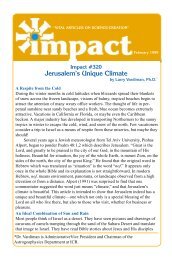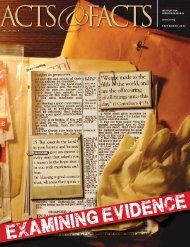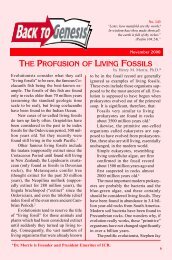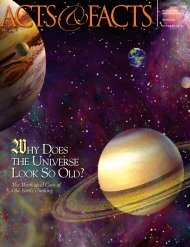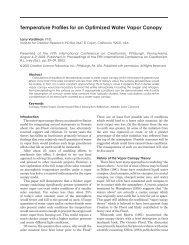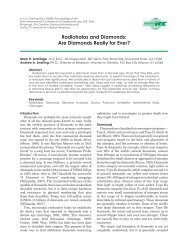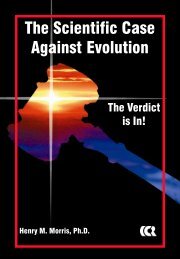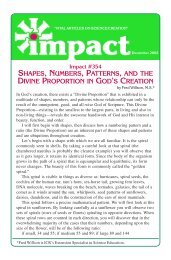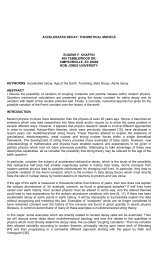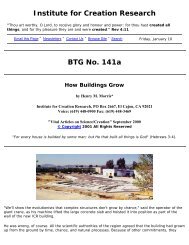Download September 2008 PDF - The Institute for Creation Research
Download September 2008 PDF - The Institute for Creation Research
Download September 2008 PDF - The Institute for Creation Research
You also want an ePaper? Increase the reach of your titles
YUMPU automatically turns print PDFs into web optimized ePapers that Google loves.
RESEARCHMeteorite Analysis BeginsLarry Vardiman, P h . D .When ICR’s Radioisotopes andthe Age of the Earth (RATE)study ended in 2005, severalprojects had not been completed.Among these were studies on meteorites,additional carbon-14 work on diamonds,and expanded sampling of helium in zircons.After a few years’ delay, we have begun to followup on these remaining projects.In spring <strong>2008</strong>, the 7-pound chondriticmeteorite shown in the accompanying picturewas purchased <strong>for</strong> meteorite studies. <strong>The</strong> meteoritewas found in the Sahara Desert in 1998and sold by a commercial Paris vendor to ICR<strong>for</strong> our analysis. Dr. Andrew Snelling is the principalinvestigator (PI) <strong>for</strong> the meteorite projectand plans first to obtain mineralogical analysesand make a thin section that he can examineMeteorite to be analyzed by RATE scientists.Photo by Larry Vardiman.through a microscope to determine the typesand relative amounts of the different mineralsit contains. He then plans to send most ofthe remaining portion to various commerciallaboratories to measure isotope ratios in severalof the minerals.Our hope is that the results of these laboratoryanalyses will indicate that the differentminerals comprising the meteorite contain ratiosof radioactive parent and daughter elementsthat are sufficiently different from one anotherthat isochron studies can be done like thosepreviously completed on basalts, granites, andother rocks in the RATE program. We desire todetermine whether similar accelerated nucleardecay processes have occurred in meteorites inspace as have been demonstrated to occur inminerals on earth. Because the conventional4.5-billion-year age of the earth is based on isotopicstudies on meteorites, it is important thatthis study be completed to complement whatwas previously found in RATE.Also in spring <strong>2008</strong>, Dr. John Baumgardner,PI <strong>for</strong> the carbon-14 project, beganworking with a second laboratory to continuethe study of carbon-14 in diamonds. <strong>The</strong> techniqueof analyzing diamonds <strong>for</strong> carbon-14has improved with a new process of insertingsmall portions of diamonds directly into theAccelerator Mass Spectrometer instead of firstgrinding them into tiny chips and combustingthem. <strong>The</strong> new process reduces the possibilityof contamination and provides more confidencein the measured levels of carbon-14. ICRhas purchased additional diamonds <strong>for</strong> thesenew analyses. Dr. Baumgardner hopes to gaindeeper insight into the means by which the carbon-14with its very short half-life came to existinside the diamonds.<strong>The</strong> search <strong>for</strong> additional deep cores ingranite from which zircons can be extracted <strong>for</strong>helium content and diffusion is scheduled tobegin in 2009. We hope to find one or two newsites in different locations from which we canobtain samples to replicate the earlier RATEresults. We don’t anticipate that the results willbe different, but believe it is important to demonstratethat our results <strong>for</strong> the original corefrom New Mexico will occur in other settingselsewhere in the world.If you are interested in these researchprojects but have not yet read the originalRATE report, you may wish to obtain a copy ofour book Radioisotopes and the Age of the Earth,Vol. II: Results of a young-earth creationist researchinitiative. It can be ordered through the ICRwebsite at www.icr.org/store, or by calling800.628.7640.Dr. Vardiman is Director of<strong>Research</strong>.6 ACTS&FACTS • SEPTEMBER <strong>2008</strong>



